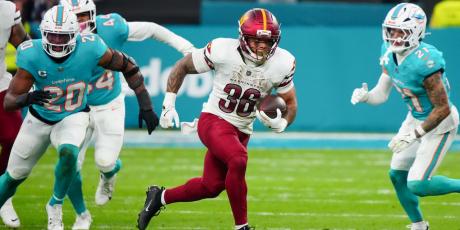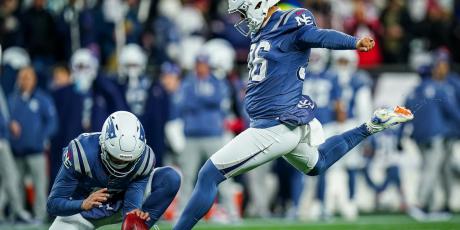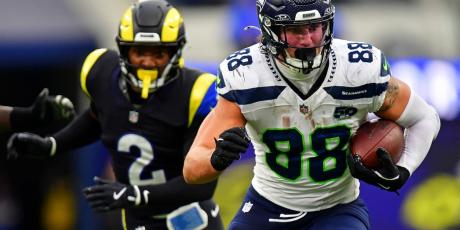How 2023 Fantasy Football Projections Impact Your Salary Cap Draft

The NFL landscape, and therefore fantasy football, is an ever-changing environment. The past decade has seen workhorse running backs make way for committees while dual-threat quarterbacks become increasingly common, and fantasy drafters have had to adapt accordingly. On top of these macro-level changes, there are nuances from season to season that impact how you should approach fantasy drafts. Each year I set out to identify emerging trends among positional value that your leaguemates haven’t caught on to yet.
We can compare 4for4’s 2023 projections to prior years and see where we’re expecting changes in player value. Value is determined by a combination of a player’s points scored over a replacement player (VORP) and the last starter at their position (VOLS), ultimately producing a quantifiable score for each player’s 2023 projections. By comparing these trends across tiers and positions, you can assemble pockets of the draft board to target or avoid based on their projected value compared to historical data.
All numbers below are focused on a 12-team PPR league with a salary cap draft, but the underlying trends are common across league types and apply to any draft format.
Quarterbacks
Last season was historically strong for top-tier QBs, with the top four quarterbacks all outperforming their historic average values, while mid-tier quarterbacks largely underperformed. Coming into 2023, we see a clear top grouping of elite quarterbacks in Josh Allen, Patrick Mahomes, and Jalen Hurts. The projected value of the top QB this year (Hurts) is $38, down from $45 the prior year, but the average value of the top three options has increased from $32 to $34. This shows that we have a tighter group of elite options, which gives you more flexibility on draft night if you set your sights on drafting one.
There's a widening value gap between the top and bottom of the position in 2023. The top six quarterbacks have an average projected value of $29, up from $26 in last season's projections, while the back end of QB1s saw their projected value drop from $13 to $11. The early-round quarterback approach has slowly gained traction in recent years, and this year it projects to be more viable than ever. Even if you miss out on the aforementioned elite options, you can still land great value by drafting Lamar Jackson, Joe Burrow, or Justin Fields, all of whom have a projected value of $22. And if you get priced out of these options, you'll still probably want to draft one of Justin Herbert, Trevor Lawrence, or Daniel Jones, since there's a notable tier drop after Jones at QB9.
This year, my plan of attack is to aim at the top QB options of Hurts, Mahomes, or Allen, a strategy that I've dedicated a whole article to promoting. If you notice quickly that these players are overpriced by your league, set your sights on the next tier of options in Burrow, Jackson, or Fields. If spending is still hot, repeat this process in hopes of landing Herbert, Lawrence, or Jones. The goal is to capitalize on the widening gap between elite quarterback options and replacement-level players, which your league mates are probably slower to recognize.
You'll notice that the top QB options through Daniel Jones either have strong rushing upside, with an outlook of 400+ rushing yards in 2023, or the belief that they can produce high-volume and efficient passing numbers like Herbert, Lawrence, or Burrow. Once we reach QB10 and beyond, we see safe but non-elite passers like Kirk Cousins and Tua Tagovailoa who don't contribute much on the ground, or quarterbacks with rushing upside but less certainty like Anthony Richardson or Deshaun Watson. In more shallow leagues, it's usually best to swing for the fences with an upside pick and scrub the waiver wire if things don't work out. I even advocate for pairing a pick like Richardson or Watson with one of the safer options for a couple of weeks until we see if the outlook is promising once games get underway.
Running Backs
This season marks a steep drop in the outlook for running backs, especially for fantasy football veterans who have had it ingrained in their minds that this position is the key to championships. In 2022, the RB1 through RB8 all delivered values below their historical averages. We missed out on any true game-breaking, league-winning asset at the position, as Austin Ekeler was the least valuable RB1 that we've seen in over seven years. But the high-end running backs as a whole still performed better than in 2021, so maybe the receiver-heavy shift that we're seeing is really past due as the running back landscape changes and we see less of the historic seasons that elite backs once delivered.
The first three running backs off the board this season have an average projected value of $69, compared to $87 in last year's projections. Austin Ekeler's value as the projected RB1 overall is $73, which is lower than the $76 for last year's projected RB3 (also Ekeler). This continues through the RB12, with the average outlook for the group down from $66 to $56 year on year. The market is telling us that we have less confidence in high-end running backs, specifically in their ceiling. It's not unheard of for the RB1 at the end of the season to have delivered $100+ in value, but in 2023 we're less certain who that will be or if it will even happen. This explains why we're seeing increasingly more drafters opt for wide receivers, or even tight ends or quarterbacks, with their early picks.
What the position lacks in true studs this year it makes up for in depth. The RB13 through RB24, by many considered to be the often-discussed running back dead zone, has a flat average outlook of $34 year over year. In fact, the back half of that group is up to an average of $29 in 2023 vs. $24 last season, even though they typically only return $23 in value. The fantasy football community has more faith in these running backs as high-floor options that can return value on their draft price, and the elite backs have less of an edge over them than we typically see. The typical RB3 range, from RB25 to RB36, has a projected value of $20 vs. just $16 last year. Guys like Dameon Pierce, James Cook, and David Montgomery are all projecting outlooks that would push them much higher up the draft board in prior years.
More than any other position, you need to read the room on draft night to determine your plan of attack at running back. Is your league recognizing the drop in value appropriately? If not, and you see them bidding multiple backs into the $70+ range, sit back and allocate your assets toward the typical dead zone, primarily focusing on low-end RB2s or high-end RB3s. This is also the area of salary cap drafts where values typically emerge, so you can stack your team in other positions and fill your RB slots with cheap assets that won't lose you weeks. But there's also a chance that your league is overreacting, and nobody wants to touch these running backs after doing their research. If that's the case, spring for one of the elite top-six options. They have incredibly high floors and hit rates, even if they don't present the same game-breaking upside we've seen in years past. An anchor RB approach that pairs a high-end RB1 with cheaper assets later has become increasingly popular over the years, and can really set your roster up for success in 2023.
Wide Receivers
Fantasy managers are asking a lot of their wide receivers in 2023. Justin Jefferson pops as the WR1 off the board, with a projected outlook of $73. Historically, the average overall WR1 delivers $70 in value. This means that for Jefferson to pay off his draft price, he would need to be more valuable than we normally see the top receiver, and even more valuable than his $69 performance last season. This isn't a case against Jefferson so much as it shows how the landscape has shifted toward receivers this year. That being said, top-six receivers have an average value outlook of $53, just $2 over prior years and in line with how they historically perform, so the position isn't abnormally front-loaded. And the top twelve wide receivers are flat with last year's projections and historical performance.
Things get thinner after the top options. The average WR2 is seeing their projected value drop from $24 in last year's projections to $15 this season. The WR3 options see a decrease as well, but it's less drastic. This explains why we're seeing the elite receivers move up draft boards in 2023, the later options look to present less value than we would typically expect, which gives the top options more of a positional edge. Almost every year drafters will claim that the wide receiver position is deep, often fixating on name recognition and upside cases, but more than ever that doesn't seem to be the case this season.
You can really build your 2023 draft around how you plan to attack wide receivers. If you want to frontload, aim to land at least one or two top-twelve options, they look to be as valuable as ever. The WR2s in your league are likely to be inflated by drafters who aren't aware of the change in positional landscape, creating a type of WR dead zone that I'd recommend avoiding. Once you're past the WR1s, shift your focus toward running back depth, a mid-tier quarterback, or a strong tight end option. You can build your team around elite wide receivers in 2023, or fill your roster with cheap options, but I don't recommend springing for mid-tier players that are likely to be overvalued.
Tight Ends
Travis Kelce comes, and Travis Kelce goes. The perennial top tight end seems to be alternating between game-breaking seasons and "just" elite seasons, and in 2022 he broke the game with by far the most valuable tight end season in over seven years. Accordingly, fears of his decline have been temporarily pushed back this season. Kelce's projected value in 2022 was $42, which he absolutely shattered by delivering $90 in total value, and this year his current outlook is $53. The average TE1 overall delivers $56 in value, with a floor of $47, so this draft price is pretty appropriate given the edge that Kelce can give you.
You probably know by now whether or not you're interested in grabbing Kelce at the top of the draft. If you are, you can spring for him and still find pockets of value at the other positions. The other top names like Mark Andrews, T.J. Hockenson, and George Kittle are in line with expectations in terms of prior season projections and historical output. The value of these top options hinges on whether or not drafters are able to find a late-round breakout tight end; there's no reason to think you can't do that in 2023, but it always looks easier in projections than it is in reality. Back-end TE1s are projected in line with typical expectations, with the only caveat being that Kyle Pitts and Evan Engram might have a slight edge over where players of their rank would typically land.
Of all positions in 2023, tight end will feel the most familiar from a value outlook perspective. Travis Kelce looks to provide an elite edge, there are a few high-end options behind him, and many drafters will find themselves throwing darts at whoever they can draft for $1. You can go into draft night with a clear goal on how you'll approach tight ends, because your league mates will probably behave in a fairly predictable way, limiting the need for flexibility.
Bottom Line
The 2023 season projects to be a bit different from others across positions, and you should keep the following in mind on draft night:
- High-end quarterbacks are as important as ever, and it's a valuable strategy to grab one at the top of your draft. If you don't, mid-tier quarterbacks are still a great bet, so don't wait around for the late-round options just because you can't get an elite QB.
- It looks like 2023 lacks truly elite running back options, but the position is historically deep. Building a roster of RB2s and RB3s while investing heavily in other positions can be a really valuable approach, but that doesn't mean you should let your league draft top options at notable discounts.
- It's best to draft one or two top-end wide receivers before you get to a range of WR2s and WR3s that your league will probably overvalue. If you can't land the elite options, play the waiting game and fill your lineup with cheap assets in the later parts of the draft.
- Tight ends look pretty consistent with prior years, the biggest question is whether or not you want to find Travis Kelce on your roster. There's some appeal to mid-round tight ends, and the late-round options are as much of a crapshoot as they ever are.























